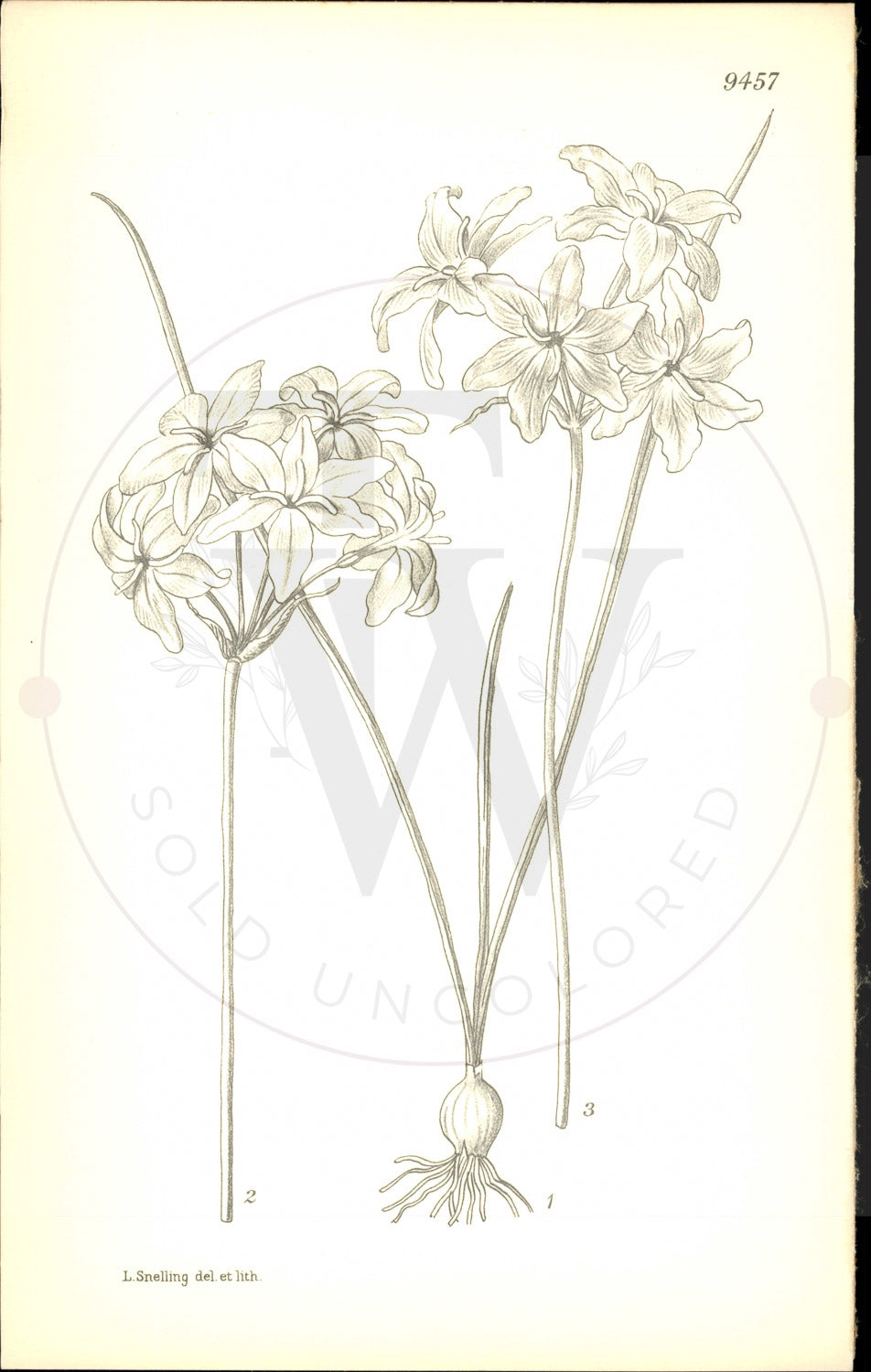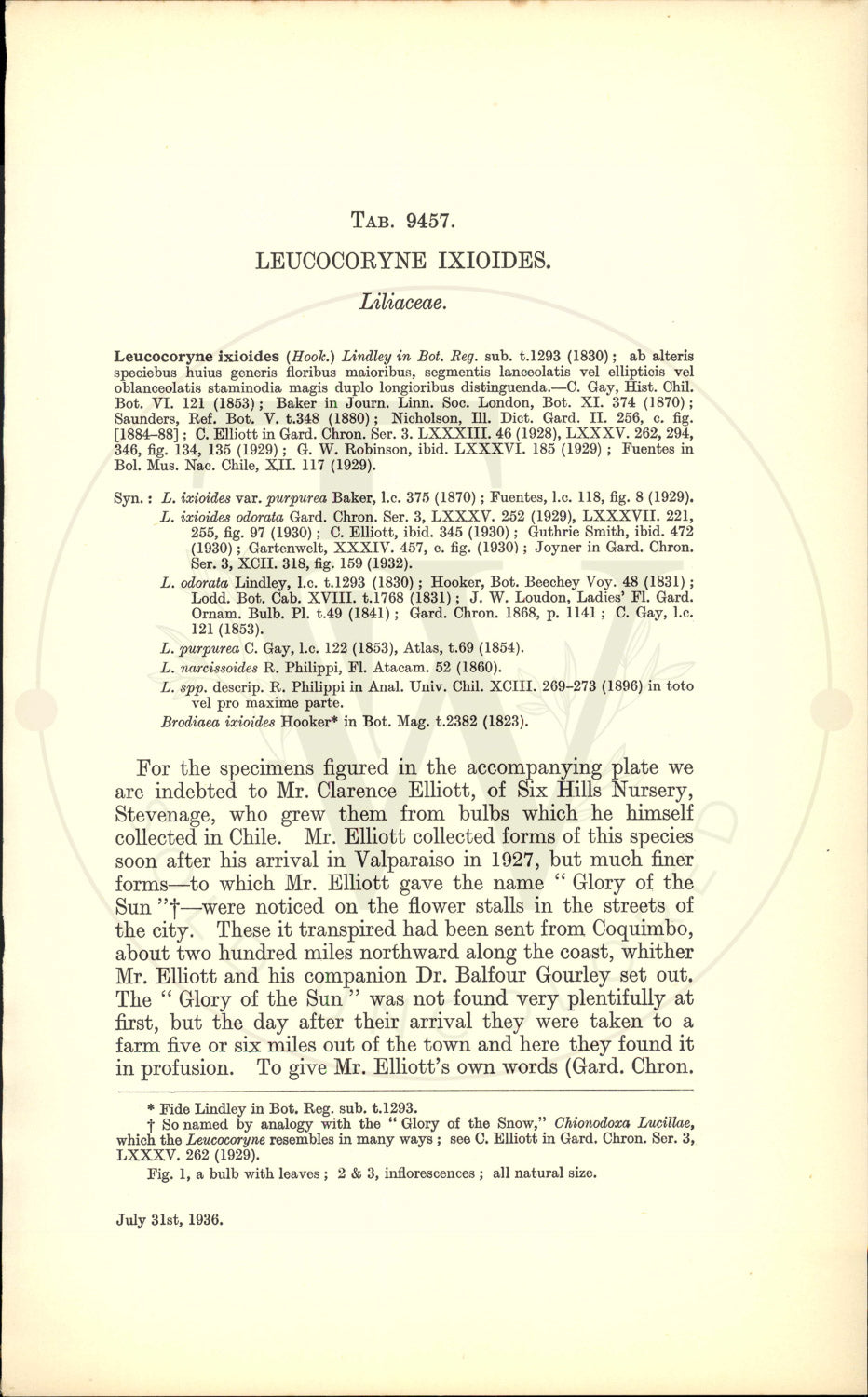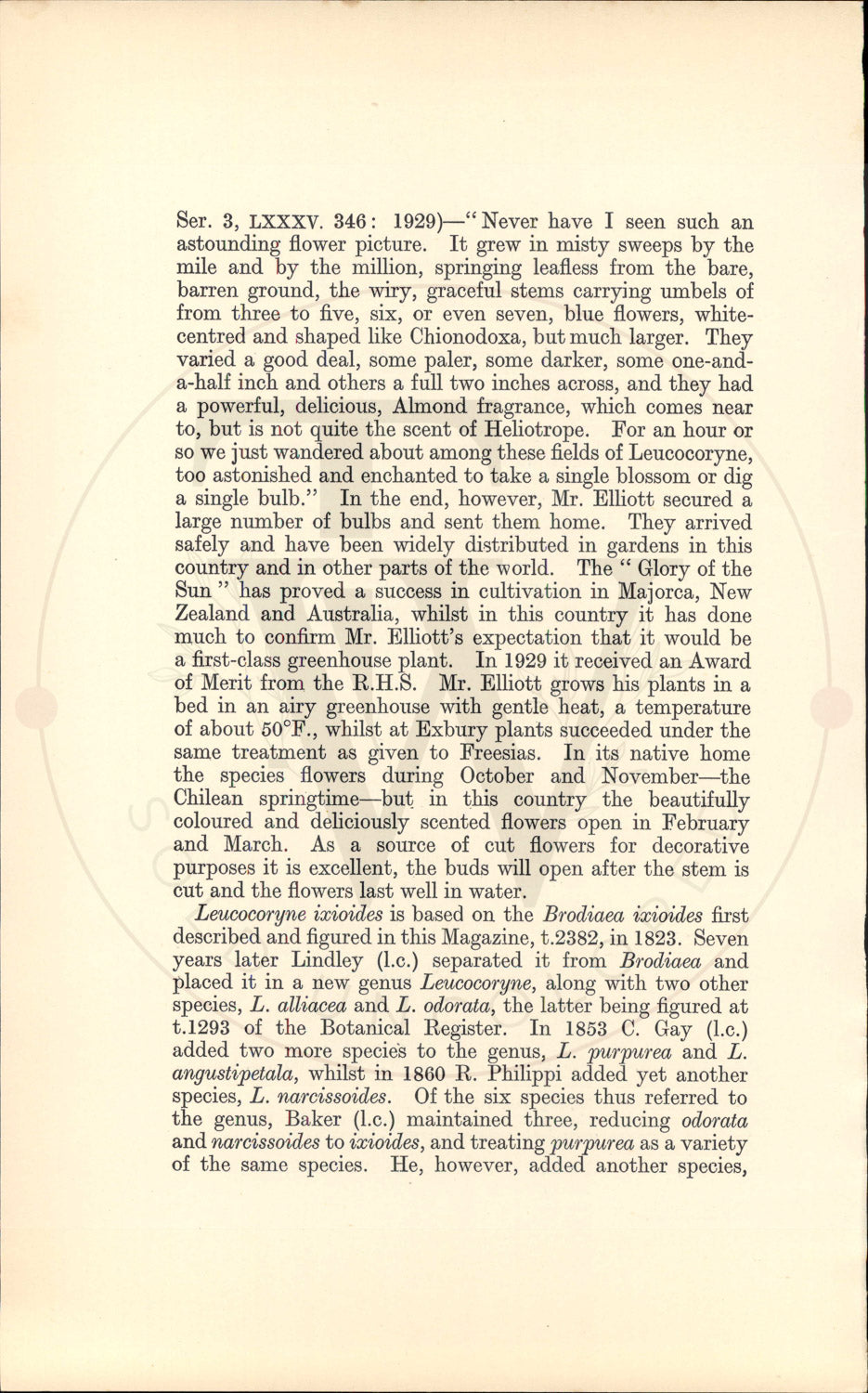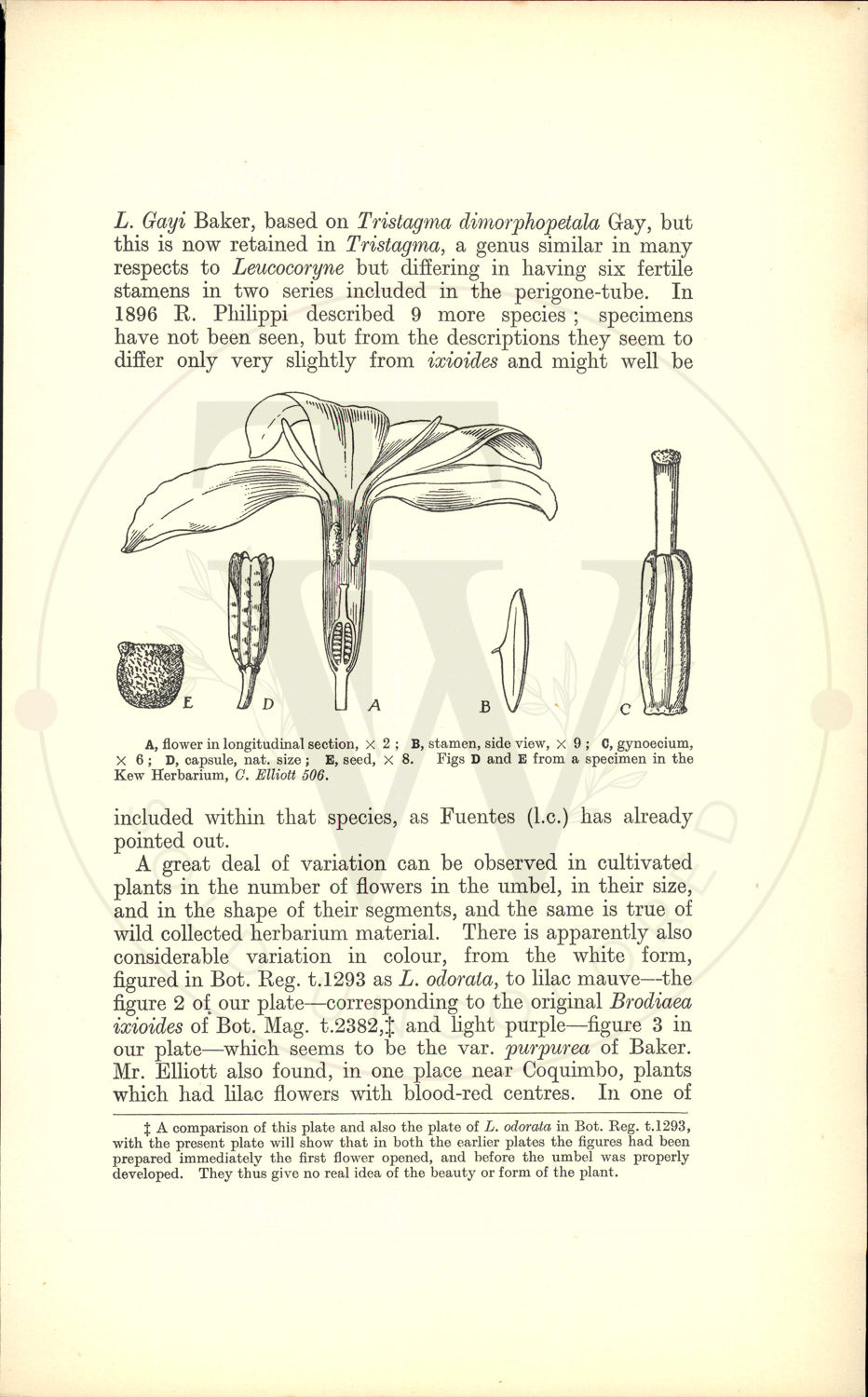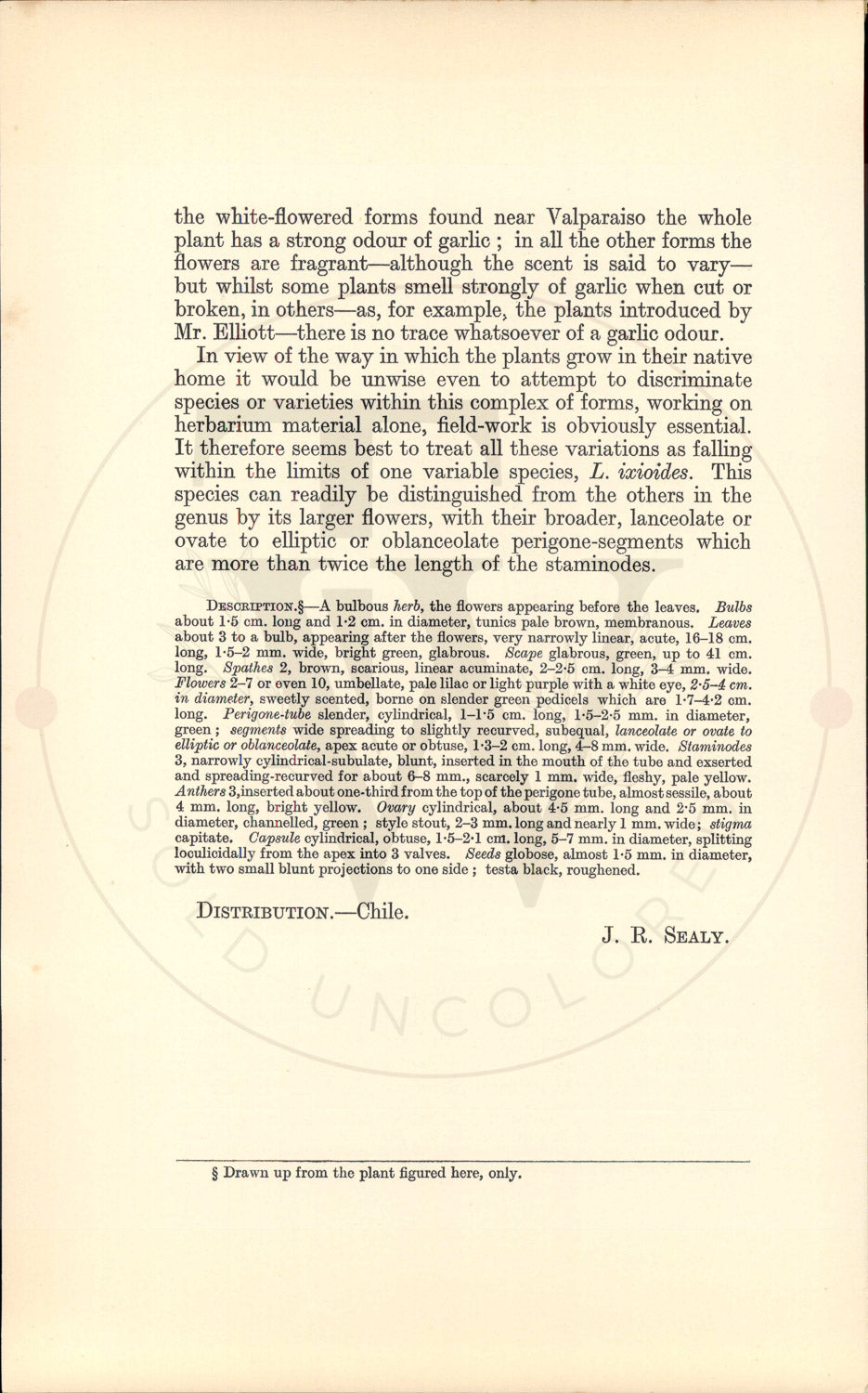Curtis Botanical Magazine
Plate 9457 - Leucocoryne ixioides
Plate 9457 - Leucocoryne ixioides
Couldn't load pickup availability
Curtis's Botanical Magazine - Plate 9457
Leucocoryne ixioides
Native Region: Chile • Publication Date: January 1st, 1934
Distribution: -Chile • Tab Author: J. R. SEALY
Botanical Description
A first-class greenhouse plant. In 1929 it received an Award of Merit from the R.H.S. Mr. Elliott grows his plants in a bed in an airy greenhouse with gentle heat, a temperature of about 50 degreesF., whilst at Exbury plants succeeded under the same treatment as given to Freesias. In its native home the species flowers during October and November-the Chilean springtime-but in this country the beautifully coloured and deliciously scented flowers open in February and March. As a source of cut flowers for decorative purposes it is excellent, the buds will open after the stem is cut and the flowers last well in water. Leucocoryne ixioides is based on the Brodiaea ixioides first described and figured in this Magazine, t.2382, in 1823. Seven years later Lindley (l.c.) separated it from Brodiaea and placed it in a new genus Leucocoryne, along with two other species, L. alliacea and L. odorata, the latter being figured at t.1293 of the Botanical Register. In 1853 C. Gay (1.c.) added two more species to the genus, L. purpurea and L. angustipetala, whilst in 1860 R. Philippi added yet another species, L. narcissoides. Of the six species thus referred to the genus, Baker (l.c.) maintained three, reducing odorata and narcissoides to ixioides, and treating purpurea as a variety of the same species. He, however, added another species, L. Gayi Baker, based on Tristagma dimorphopetala Gay, but this is now retained in Tristagma, a genus similar in many respects to Leucocoryne but differing in having six fertile stamens in two series included in the perigone-tube. In 1896 R. Philippi described 9 more species; specimens have not been seen, but from the descriptions they seem to differ only very slightly from ixioides and might well be E EFERE A B A, flower in longitudinal section, x 2; B, stamen, side view, x 9; C, gynoecium, x 6; D, capsule, nat. size; E, seed, X 8. Figs D and E from a specimen in the Kew Herbarium, C. Elliott 506. included within that species, as Fuentes (l.c.) has already pointed out. A great deal of variation can be observed in cultivated plants in the number of flowers in the umbel, in their size, and in the shape of their segments, and the same is true of wild collected herbarium material. There is apparently also considerable variation in colour, from the white form, figured in Bot. Reg. t.1293 as L. odorata, to lilac mauve--the figure 2 of our plate-corresponding to the original Brodiaea ixioides of Bot. Mag. t.2382, and light purple-figure 3 in our plate which seems to be the var. purpurea of Baker. Mr. Elliott also found, in one place near Coquimbo, plants which had lilac flowers with blood-red centres. In one of A comparison of this plate and also the plate of L. odorata in Bot. Reg. t.1293, with the present plate will show that in both the earlier plates the figures had been prepared immediately the first flower opened, and before the umbel was properly developed. They thus give no real idea of the beauty or form of the plant. the white-flowered forms found near Valparaiso the whole plant has a strong odour of garlic; in all the other forms the flowers are fragrant-although the scent is said to vary- but whilst some plants smell strongly of garlic when cut or broken, in others-as, for example, the plants introduced by Mr. Elliott-there is no trace whatsoever of a garlic odour. In view of the way in which the plants grow in their native home it would be unwise even to attempt to discriminate species or varieties within this complex of forms, working on herbarium material alone, field-work is obviously essential. It therefore seems best to treat all these variations as falling within the limits of one variable species, L. ixioides. This species can readily be distinguished from the others in the genus by its larger flowers, with their broader, lanceolate or ovate to elliptic or oblanceolate perigone-segments which are more than twice the length of the staminodes. DESCRIPTION. -A bulbous herb, the flowers appearing before the leaves. Bulbs about 1.5 cm. long and 1-2 cm. in diameter, tunics pale brown, membranous. Leaves about 3 to a bulb, appearing after the flowers, very narrowly linear, acute, 16-18 cm. long, 1.5-2 mm. wide, bright green, glabrous. Scape glabrous, green, up to 41 cm. long. Spathes 2, brown, scarious, linear acuminate, 2-2.5 cm. long, 3-4 mm. wide. Flowers 2-7 or even 10, umbellate, pale lilac or light purple with a white eye, 2.5-4 cm. in diameter, sweetly scented, borne on slender green pedicels which are 1-7-4-2 cm. long. Perigone-tube slender, cylindrical, 1-1.5 cm. long, 1.5-2.5 mm. in diameter, green; segments wide spreading to slightly recurved, subequal, lanceolate or ovate to elliptic or oblanceolate, apex acute or obtuse, 1-3-2 cm. long, 4-8 mm. wide. Staminodes 3, narrowly cylindrical-subulate, blunt, inserted in the mouth of the tube and exserted and spreading-recurved for about 6-8 mm., scarcely 1 mm. wide, fleshy, pale yellow. Anthers 3,inserted about one-third from the top of the perigone tube, almost sessile, about 4 mm. long, bright yellow. Ovary cylindrical, about 4-5 mm. long and 2.5 mm. in diameter, channelled, green; style stout, 2-3 mm. long and nearly 1 mm. wide; stigma capitate. Capsule cylindrical, obtuse, 1.5-2.1 cm. long, 5-7 mm. in diameter, splitting loculicidally from the apex into 3 valves. Seeds globose, almost 1.5 mm. in diameter, with two small blunt projections to one side; testa black, roughened. DISTRIBUTION.-Chile. Drawn up from the plant figured here, only. J. R. SEALY.
Synonyms
L. ixioides var. purpurea Baker
L. ixioides odorata Gard. Chron. Ser. 3
(1930)
About This Print
Original black and white uncolored botanical print from Curtis's Botanical Magazine (established 1787). This 9000s series print is from unissued publisher stock, never hand-colored, representing the authentic plate as it appeared in the magazine. Edited by Sir Arthur William Hill for The Royal Horticultural Society, London.
Share
